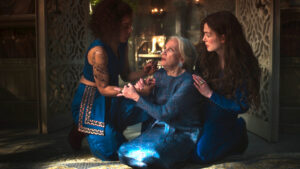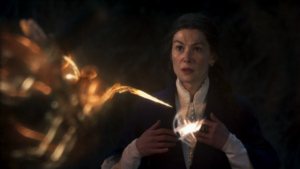SPOILERS FOR THE WHEEL OF TIME BOOK FOUR: THE SHADOW RISING, AND POTENTIAL SPOILERS FOR THE WHEEL OF TIME SEASON THREE, AHEAD!
Amazon’s The Wheel Of Time would need a much larger budget to visit every single location from Robert Jordan’s fourteen-volume series of books, but the show has managed to cover a fair bit of ground in just two seasons; and the upcoming third season looks to be the most ambitious yet in that regard, with characters scattered in every corner of the world, from Emond’s Field to the Aiel Waste, from Tar Valon to Tanchico. Each of these locations has a history and a culture that shows through in every aspect of the lavish production design, set design, VFX environment design, costume, hair and makeup design. Via Nerdist, we now have our first look at how The Wheel Of Time is bringing the city of Tanchico from page to screen, with new images to pore over and discuss.

Tanchico is the capital city of the nation of Tarabon. Before that, it was the capital of Balasun, a kingdom that ceased to exist when it was annexed by the emperor Artur Hawkwing; and before that, it was named Mainelle, and was the capital of the kingdom of Aelgar, which arose out of the Breaking of the World. Tanchico is thus considered to be one of the oldest cities in the world, and indeed there are sections of the city that date back to before the Breaking, including the foundations of the palace complex sprawling across the hills above the city, where the ‘Panarch’, one half of Tarabon’s ruling diarchy, resides. The Panarch is always a woman, elected by the Assembly of Lords to counterbalance the male King whose power is inherited. Among other duties, the Panarch oversees the court system and civil affairs in Tarabon, while the King commands the nation’s army. Tarabon is locked in a perpetual power struggle with its neighbor to the north, Arad Doman, over Almoth Plain (the unclaimed territory between the two that encompasses the free city of Falme), and with its neighbor to the south, Amadicia, which is ruled by the Whitecloaks. In the books, the Whitecloaks who fought at Falme were there not to liberate the city from the Seanchan, but to try and set up a vassal state of Amadicia on Almoth Plain, which would have put pressure on Tarabon from both sides to submit to Whitecloak rule, if they had succeeded. That nuance was sadly lost in the show, and frankly, I wouldn’t expect most of what I’ve just written to make it into dialogue or anything, but I think the context is valuable regardless.
The Panarch’s Palace in Tanchico is also home to the world’s largest collection of pre-Breaking artifacts, many of them ter’angreal — objects sculpted from the One Power itself by the Aes Sedai of ages past, designed to fulfil specific tasks. Among these are the ‘Domination Bands’, comprised of a collar and two bracelets, which in both function and design very closely resemble the a’dam, the mass-produced ter’angreal which the Seanchan use to control female channelers. Just as the a’dam consists of a collar that prevents the woman wearing it (called the damane) from independently accessing the One Power, and a matching bracelet with which another woman (called the sul’dam) may wield the One Power through the damane, the Domination Bands are meant to be worn around the throat of a male channeler and the wrists of not one but two female handlers (because, for reasons I refuse to believe are anything but sexist, both the base level and ceiling for male channelers are much higher than for female channelers). Where the Domination Bands differ greatly from the a’dam is that with time, the collared male is able to gain the same power over the woman/women wearing the bracelets that they possess over him (again, feels sexist), and neither collar nor bracelet can be removed without the cooperation of the collared and braceleted: essentially meaning they’re on for life. And because male channelers tap into a strain of the One Power that is ‘tainted’ by the Dark One, invariably leading to a fatal madness that can be transferred through the Domination Bands, those lives will be short and painful for everyone involved.

Nonetheless, the Domination Bands are coveted by many for the potential they might have to decide the outcome of the fast-approaching Last Battle where Rand al’Thor, the strongest male channeler since the Breaking of the World, will face the Dark One. A woman or two women wearing the bracelets could theoretically prevent Rand from joining the Dark One on that fateful day, or alternatively, force him to do just that (obviously, Rand’s free will goes out the window in both these scenarios, but neither side is particularly concerned about that, to be honest). In book four, The Shadow Rising, Liandrin Guirale of the Black Ajah — an underground faction of the Aes Sedai made up of women sworn to the Dark — arrives in Tanchico on a mission to obtain the Domination Bands for the Dark One, with designated ‘Black Ajah hunters’ Nynaeve al’Meara and Elayne Trakand hot on her heels.
Nynaeve and Elayne have help in the books from the gleeman Thom Merrilin, the rat-catcher and reconnaissance man Juilin Sandar, ship-captain Bayle Domon, and Seanchan warrior Egeanin — but while two of those characters, Thom and Bayle, have shown up in the television adaptation, so far only Thom is confirmed to be returning for season three, and as for Juilin and Egeanin, we have no idea if they exist in this ‘Turning of the Wheel’. I feel pretty confident that the man in the black hat seen speaking to Nynaeve in one of the first look images released recently is either Juilin or a character based on Juilin. Egeanin, on the other hand, is someone I would have expected to see introduced in season two if she had made the cut. In place of these missing characters, the show is roping Mat Cauthon and Min Farshaw into the Tanchico subplot: a consequential (and controversial) change with many potential downsides and fewer immediately apparent upsides – except the fact that Mat gets a long-overdue costume change as a result. And on that note…
The Wheel Of Time‘s costume design has always been eclectic, reflecting how the world of Robert Jordan’s novels was pieced back together again after the catastrophic Breaking in its ancient past, with people having to build entirely new cultures by sharing freely what was left of the old. Even so, most of the cultures we’ve glimpsed in the show have had one or two prevailing real-world influences – Franco-Chinese in Cairhien, Andalusian in Ghealdan, South Asian in Arafel, Southeast Asian in Tear, etc. Tarabon as a whole may have a single real-world influence (in the books, I’d say it has a vaguely Eastern Mediterranean vibe), but the city of Tanchico is a melting pot, and this is apparent in its fashion, with its inconsistent silhouettes and panoply of fabrics. There’s only one rule in effect: regardless of age, class or gender, everyone wears veils or half-veils. Costume designer Sharon Gilham has outdone herself with the disguises being sported by the main characters — from Nynaeve’s uncharacteristic but oh-so-gorgeous red-and-gold pantsuit and beaded black eye-covering to Mat’s whole garish ensemble, a frilly maroon coat worn over a saffron-yellow shirt and a black lace veil adorned with flower appliqués.

Less lavishly dressed, what appears to be a young Liandrin Guirale is shown cradling a baby at the foot of a statue that depicts a one-armed man in chains, with the a’dam collar around his neck. While it’s not confirmed to be Liandrin, she was canonically born in Tarabon, we know she’s going back there (so if ever there was a time for flashbacks to her origins it would be now), and it would also line up with the backstory invented for her character in the show; where she has a son from an arranged marriage she was forced into as a young girl. Perhaps this scene, or the longer sequence it’s part of, will show how Liandrin came to be recruited by the Black Ajah for love of her child…setting up the heel-turn I predict from her late in the season, when Nynaeve al’Meara, whom she regards almost like a second child, will be in danger (just a guess on my part, not a spoiler; Liandrin in the books is a very different character, with no redeeming qualities).
So that’s our first look at Tanchico. How does it compare to what you imagined from the books? As always, share your own thoughts, theories, and opinions, in the comments below!

















